History
 I am sometimes amazed at the ability of humans to be heinously cruel to other human beings. From murders, to slave owners, to prisons or prisoner of war camps, man has the ability to act out evil in its purest form. Still, one would not have expected such evil in the American Revolutionary War era. Well, one would be wrong. We all know that war is a horrific event, but worse than losing life and limb in battle, seems to be the fate faced by those who are captured by the enemy forces, only to be tortured and even killed.
I am sometimes amazed at the ability of humans to be heinously cruel to other human beings. From murders, to slave owners, to prisons or prisoner of war camps, man has the ability to act out evil in its purest form. Still, one would not have expected such evil in the American Revolutionary War era. Well, one would be wrong. We all know that war is a horrific event, but worse than losing life and limb in battle, seems to be the fate faced by those who are captured by the enemy forces, only to be tortured and even killed.
During the Revolutionary War, being captured by the British often meant being sent to a prison ship, the worse of which was the HMS Jersey. Over the years of the war, approximately 11,000 prisoners of war perished on the HMS Jersey. The number of American field casualties during that war was approximately 4,500. That is a stunning difference. The HMS Jersey often held thousands of prisoners at one time, in quarters that were so close, that it could be likened to being packed in like sardines in a tin. There was no light, no medical care, barely any oxygen, and very little in the way of food and clean water. The guards on the prison ships were not concerned with keeping their prisoners alive, and HMS Jersey was the worst of them all.
The little food the prisoners were given was moldy, putrefied, and worm infested. The prisoners had to choose daily to eat the horrible food, or starve. One prisoner Ebenezer Fox, who survived said, “The bread was mostly mouldy, and filled with worms. It required considerable rapping upon the deck, before these worms could be dislodged from their lurking places in a biscuit. As for the pork, we were cheated out of it more than half the time, and when it was obtained one would have judged from its motley hues, exhibiting the consistence and appearance of variegated soap, that it was the flesh of the porpoise or sea hog, and had been an inhabitant of the ocean, rather than a sty. The provisions were generally damaged, and from the imperfect manner in which they were cooked were about as indigestible as grape shot.” That pretty much says it all, I would say. The British soldiers were seemingly unaffected by the image of prisoners banging their biscuits against the deck to remove worms, because this treatment continued throughout the conflict.
Because the prisoners were kept at sea, the smell of a piece of dirt from the shoes of a soldier back from shore leave became one of the prisoners’ greatest delights. I guess that one can always find some good, even in the worst situations, if one looks for it. Captain Dring, a survivor who wrote prolifically about his experiences on the Jersey, recalled one particularly strange consolation. When someone died on the ship, their remains were usually thrown overboard, but occasionally they were allowed to be taken ashore and laid to rest. Dring was part of a group that was tasked with digging graves on land. The men chosen for this duty were ecstatic to be on land again. Dring even took off his boots simply to feel the earth underneath his feet. However, when the crew came across a piece of broken-up turf, they did something extraordinary: “We went by a small patch of turf, some pieces of which we tore up from the earth, and obtained permission to carry them on board for our comrades to smell them. Circumstances like these may appear trifling to the careless reader; but let him be assured that they were far from being trifles to men situated as we had been. Sadly did we approach and reenter our foul and disgusting place of confinement. The pieces of turf which we carried on board were sought for by our fellow prisoners, with the greatest avidity, every fragment being passed by them from hand to hand, and its smell inhaled as if it had been a fragrant rose.”
The known fate of the men on board the prison ships, and especially HMS Jersey was a slow and painful death. Most knew better than to expect to survive their ordeal. They had seen too many of their comrades die right before their eyes, to have much hope that they could make it out. To make mattes worse, the majority of the prisoners aboard the Jersey were young, inexperienced farmhands, not hardened soldiers with survival experience. Only a few of Washington’s army were soldiers with any 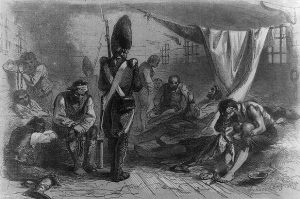 experience. The rest were provincial people, and many had never traveled beyond the limits of the small county where they lived. Imagine the horror of war, and then the conditions on HMS Jersey to the young, innocent men. The constant punishment, meager rations, lack of light, and lack of privacy could be tolerated, but the inactivity and helplessness most likely added depression and despair to their suffering. Times were different then, and there were things that were not available, but many of the things the prisoners suffered could have been avoided, especially the overcrowding and unsanitary conditions, but apparently they just didn’t care.
experience. The rest were provincial people, and many had never traveled beyond the limits of the small county where they lived. Imagine the horror of war, and then the conditions on HMS Jersey to the young, innocent men. The constant punishment, meager rations, lack of light, and lack of privacy could be tolerated, but the inactivity and helplessness most likely added depression and despair to their suffering. Times were different then, and there were things that were not available, but many of the things the prisoners suffered could have been avoided, especially the overcrowding and unsanitary conditions, but apparently they just didn’t care.
 These days, we all expect the latest new car to look different, to say the least, and strange, in some cases, but that is not really what we might have expected in the 1930s. Nevertheless, in 1933, they people might have been a little bit surprised to see the car designed by Richard Buckminster Fuller, an American architect, systems theorist, author, designer, inventor, and futurist. Fuller was born on July 12, 1895, in Milton, Massachusetts, the son of Richard Buckminster Fuller and Caroline Wolcott Andrews. The unusual middle name, Buckminster, was an ancestral family name. Like many kids, he tried numerous variations of his name. He used to sign his name differently each year in the guest register of his family summer vacation home at Bear Island, Maine. He finally settled on R. Buckminster Fuller. Not what I would have expected, but to each his own.
These days, we all expect the latest new car to look different, to say the least, and strange, in some cases, but that is not really what we might have expected in the 1930s. Nevertheless, in 1933, they people might have been a little bit surprised to see the car designed by Richard Buckminster Fuller, an American architect, systems theorist, author, designer, inventor, and futurist. Fuller was born on July 12, 1895, in Milton, Massachusetts, the son of Richard Buckminster Fuller and Caroline Wolcott Andrews. The unusual middle name, Buckminster, was an ancestral family name. Like many kids, he tried numerous variations of his name. He used to sign his name differently each year in the guest register of his family summer vacation home at Bear Island, Maine. He finally settled on R. Buckminster Fuller. Not what I would have expected, but to each his own.
Fuller married Ann Hewitt in 1917, and they would have two daughters, Alexandra born in 1918, and Allegra, born in 1927. Following the death of his daughter Alexandria in 1922 of complications from polio and spinal meningitis just before her fourth birthday, Fuller suffered with depression, even contemplating suicide. Then, he made a decision to live out his life as “an experiment to find what a single individual can contribute to changing the world and benefiting all humanity.”
In 1927, Fuller sketched the Dymaxion car under the name “4D transport.” The car was most unusual in its appearance. Part aircraft, part automobile, it actually had wings that inflated. Fuller asked a friend, sculptor, Isamu Noguchi to make more sketches of the car in 1932. The final design was an elongated teardrop body, with a rear third wheel that lifted off the ground and a tail fin. Fuller set up production of the Dymaxion car in a former Locomobile factory in Bridgeport in March 1933. The first model rolled out of the Bridgeport factory on July 12, 1933…Fuller’s 38th birthday. It had a steel chassis and a body made of ash wood, covered with an aluminum skin and topped with a painted canvas roof. It was designed to be able to reach a speed of 120 miles per hour and average 28 miles to the gallon of gasoline. The first model was sold to Gulf Oil, and dubbed the Dymaxion car. It went on display at the Century of Progress exposition in Chicago. Unfortunately, that October the professional driver Francis Turner was killed after the Dymaxion car turned over during a demonstration. The Dymaxion was cleared of responsibility in the ensuing investigation, but investors became scarce, despite the enthusiasm of the press and of celebrities such as the novelist H.G. Wells and the painter Diego Rivera.
The Dymaxion, along with the Nazi-built KdF-wagen (the forerunner of the Volkswagen Beetle), was one of several futuristic, rear-engined cars developed during the 1930s. Because of the tragic death of Francis Turner,  it was never mass-produced. Still, the Dymaxion helped lead to public acceptance of new streamlined passenger cars, such as the 1936 Lincoln Zephyr. The only surviving Dymaxion was featured in an exhibit dedicated to Fuller’s work at the Whitney Museum of American Art in New York City in 2008. The New York Times, in an article about the exhibit recalled Fuller’s own impressions of the Dymaxion, “‘I knew everyone would call it a car,’ he told the literary critic Hugh Kenner in the 1960s; instead, it was actually ‘the land-taxiing phase of a wingless, twin orientable jet stilts flying device.'” Interesting analogy…don’t you think?
it was never mass-produced. Still, the Dymaxion helped lead to public acceptance of new streamlined passenger cars, such as the 1936 Lincoln Zephyr. The only surviving Dymaxion was featured in an exhibit dedicated to Fuller’s work at the Whitney Museum of American Art in New York City in 2008. The New York Times, in an article about the exhibit recalled Fuller’s own impressions of the Dymaxion, “‘I knew everyone would call it a car,’ he told the literary critic Hugh Kenner in the 1960s; instead, it was actually ‘the land-taxiing phase of a wingless, twin orientable jet stilts flying device.'” Interesting analogy…don’t you think?
 In early American history, a duel…then called an Affair of Honor were a legal way to settle disputes between parties. Most of these duels were settled amicably before the duel ever too place, still, some went the way of the full-blown duel. I can understand why the parties would try to work it out amicably, because you really never knew who was going to win in a duel, and you had to decide if this dispute was worth your life.
In early American history, a duel…then called an Affair of Honor were a legal way to settle disputes between parties. Most of these duels were settled amicably before the duel ever too place, still, some went the way of the full-blown duel. I can understand why the parties would try to work it out amicably, because you really never knew who was going to win in a duel, and you had to decide if this dispute was worth your life.
One of the most famous duels in American history, was between Vice President Aaron Burr and his long-time political antagonist, Alexander Hamilton, who was born on the Caribbean island of Nevis in either 1755 or 1757 (the exact date is under dispute). Hamilton was a poor immigrant, while Burr was born into a wealthy New Jersey family in 1756. Both were highly intelligent and became capable politicians…but had opposing views and were part of different political parties. Hamilton thought Burr was a politically dangerous man, and was quick to point out his views on the matter.
As you can imagine, Hamilton’s statements against Burr did not create a friendship between the two. Burr became vice-president to Thomas Jefferson in 1800, but his political views quickly caused the two men to grow apart politically. Jefferson did not support Burr’s re-nomination to a second term, in 1804. In the campaign, Burr’s character was savagely attacked by Hamilton and others, and after the election Burr vowed to restore his reputation by challenging Hamilton to a duel…an “affair of honor.”
As “affairs of honor” go, most were solved without gunfire, in fact, the outspoken Hamilton had been involved in several affairs of honor in his life, and he had resolved most of them peaceably. That was not to be the case here. The hatred between the two men went too deep, and there was no such willingness to resolve the matter easily. So, on July 11, 1804, the enemies met at 7am at the dueling grounds near Weehawken, New Jersey. Ironically, it was the same spot where Hamilton’s son had died defending his father’s honor in 1801. As these matters go, the events that followed were told in conflicting accounts. According to Hamilton’s “second,” (his assistant and witness in the duel), Hamilton decided the duel was morally wrong and fired into the air. Burr’s “second” claimed that Hamilton fired at Burr and missed. The seconds agreed on the next events. Burr shot Hamilton in the stomach. The bullet lodged next to his spine. He was taken back to New York. He died the next day.
The nation was outraged by the killing of a man as respected as Alexander Hamilton. Burr, who was still vice president at the time, was charged with murder. Nevertheless, he returned to Washington DC, where he finished his term immune from prosecution. In 1805, Burr, thoroughly discredited, concocted a plot with James Wilkinson, commander of the US Army, to seize the Louisiana Territory and establish an independent empire, which Burr would lead. He contacted the British government and unsuccessfully pleaded for assistance in the scheme. Later, when border trouble with Spanish Mexico heated up, Burr and Wilkinson 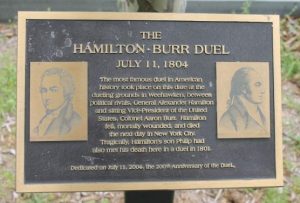 conspired to seize territory in Spanish America for the same purpose.
conspired to seize territory in Spanish America for the same purpose.
In the fall of 1806, Burr led a group of well-armed colonists toward New Orleans, prompting an immediate US investigation. General Wilkinson, in an effort to save himself, turned against Burr and sent dispatches to Washington accusing Burr of treason, or maybe insanity. In February 1807, Burr was arrested in Louisiana for treason and sent to Virginia to be tried in a US court. He was acquitted on a technicality in September. Still, public opinion called him as a traitor, and he fled to Europe. He later returned to private life in New York, the murder charges against him somehow forgotten. He died in 1836.
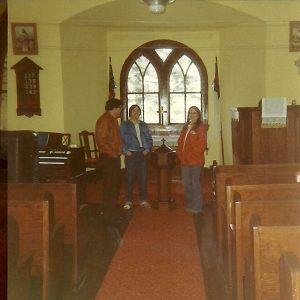
 I never got the chance to see the church in the little town of Holyoke, Minnesota, where my dad, Al Spencer and his siblings spent much of their growing up years…at least not before it fell into terrible disrepair. My dad’s parents rented a farm in the area, and the little Lutheran Church in town was their church. The kids helped on the farm and went to school in the area, but the church held a special significance to the family. Of course, being a very religious family, church was the center of their lives. Everything else came after time with the Lord. For me and my sisters, that has been something that our parents, Allen and Collene Spencer carried forward into their marriage, and we will be forever grateful for that solid Christian upbringing. That in many ways got started in that little church in Holyoke, Wisconsin.
I never got the chance to see the church in the little town of Holyoke, Minnesota, where my dad, Al Spencer and his siblings spent much of their growing up years…at least not before it fell into terrible disrepair. My dad’s parents rented a farm in the area, and the little Lutheran Church in town was their church. The kids helped on the farm and went to school in the area, but the church held a special significance to the family. Of course, being a very religious family, church was the center of their lives. Everything else came after time with the Lord. For me and my sisters, that has been something that our parents, Allen and Collene Spencer carried forward into their marriage, and we will be forever grateful for that solid Christian upbringing. That in many ways got started in that little church in Holyoke, Wisconsin.
There was something else that endeared the little church to our family, and really the reason that my family visited it on a trip back to Wisconsin. My Uncle Fritz Fredrick, who was then married to my dad’s sister, Laura, was exceptional at furniture building, and he put that talent into building the baptismal font for the church. It was a really special gift to them. In fact the story of the baptismal font and its special connection to our family is the reason my dad’s brother, Bill Spencer brought the family to the little church in the first place. Of course, my dad knew about the baptismal font, but the rest of the family who were on that trip wanted to see it firsthand. I think the most amazing part of the history of it…to us anyway, was that someone in our family had a part in it.
When the little church closed…sadly, my Uncle Bill asked for the baptismal font. He wanted it to be passed to one of Fritz’s sons. In the end, Fritz’s son Dennis ended up with the baptismal font. I’m sure it was a treasure for him. While the font was a beautiful piece of church furniture, the real treasure is that it was made by his dad’s hands. Many churches have one of a mass produced baptismal font, and they are beautiful, but this one was made with love by the hands of a family member, and that makes this one so much more special. I wish I 
 could have seen that baptismal font, in that little church in Holyoke…in the intended setting for it. It think I would have been in awe of both the baptismal font and the church. It made me very sad to see the little church in its final state…when I was finally able to get back to Holyoke. It just seems so wrong to have a church in such dilapidation…a condition that should never be the fate of a church.
could have seen that baptismal font, in that little church in Holyoke…in the intended setting for it. It think I would have been in awe of both the baptismal font and the church. It made me very sad to see the little church in its final state…when I was finally able to get back to Holyoke. It just seems so wrong to have a church in such dilapidation…a condition that should never be the fate of a church.

 It was in the middle of World War I, on the 4th of July, 1917. The citizens of Colby, Wisconsin were busy celebrating Independence Day. Colby was originally famous for the making of Colby cheese, but it was about to be famous for something else entirely. Around 6:30, the people were setting of fireworks and everyone was having a great time, when suddenly, there was a louder-than-it-should-have-been explosion. The people were startled and began to speculate as to the origin. Some thought it was dynamite set off by some over-zealous celebrators. Then, they dismissed that thought, and some of the townspeople were concerned that when the went outside, they might see a Zeppelin dropping German bombs on the little town. In the end it turned out to be something form much further away…outer space to be exact.
It was in the middle of World War I, on the 4th of July, 1917. The citizens of Colby, Wisconsin were busy celebrating Independence Day. Colby was originally famous for the making of Colby cheese, but it was about to be famous for something else entirely. Around 6:30, the people were setting of fireworks and everyone was having a great time, when suddenly, there was a louder-than-it-should-have-been explosion. The people were startled and began to speculate as to the origin. Some thought it was dynamite set off by some over-zealous celebrators. Then, they dismissed that thought, and some of the townspeople were concerned that when the went outside, they might see a Zeppelin dropping German bombs on the little town. In the end it turned out to be something form much further away…outer space to be exact.
The streak through the sky could have been missed because of the fireworks, but the explosion was another thing entirely. The meteorite hit just west of the Zion Lutheran Church, which is still there on the corner of West Jefferson Street and North 2nd Street in Colby, Wisconsin. When the townspeople located it easily, due to the smoke trail in the sky. They found that it had broken into two pieces, with the smaller piece landing just a short distance from the church, imbedded to a depth of one foot. It weighed about 75 pounds, and was said the be intensely cold, forming frost on it when it was uncovered. The larger piece landed in Joseph Jordan’s field, imbedding itself to a depth of five feet. The depth made it difficult to dig up, so it was not unearthed until the next morning when Professor Williams secured it for a school exhibit. That piece weighed about 300 pounds, and was apparently not as cold, probably due to the time spent in the ground.
It was said that another piece had landed in Cornell, Wisconsin, which is about 60 miles away from Colby. Amazingly, none of the other small towns in the area were hit. The principal of the Colby High School assumed, 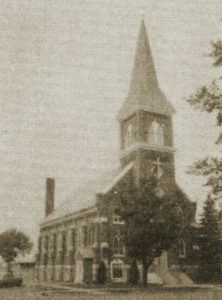 correctly as it turns out that there were likely to be other fragments too. He did some digging in the area, and is said to have found a sizeable collection of fragments. Of course, that makes sense, because as a meteor streaks through our atmosphere, the intense heat, impacting the intense cold usually causes them to break up long before they impact the Earth’s surface. Still, every so often, a particularly sturdy meteor slips through without being totally obliterated, and then we have a strike, such as the one in Colby, Wisconsin in 1917.
correctly as it turns out that there were likely to be other fragments too. He did some digging in the area, and is said to have found a sizeable collection of fragments. Of course, that makes sense, because as a meteor streaks through our atmosphere, the intense heat, impacting the intense cold usually causes them to break up long before they impact the Earth’s surface. Still, every so often, a particularly sturdy meteor slips through without being totally obliterated, and then we have a strike, such as the one in Colby, Wisconsin in 1917.
According to the Wisconsin Geological and Natural History Survey, there have been 13 documented meteorite strikes in Wisconsin since 1860. The latest one was in April 2010. Often, the way that meteorites are discovered is that someone finds a rare mineral rock, and when checked, the chemical makeup of the stone indicates that it may have originated in outer space. Of course, that doesn’t document when it happened, or if it was actually part of a documented strike. We always have been and probably always will be fascinated by the extraterrestrial.
 As we head into Independence Day 2020, many of us have begun to realize that this year, it’s different. Everything is different. The year, Independence Day has taken on a whole new meaning for me and so many others. For the first time in our nations history, almost everything was shut down. People were quarantined…leaving only the essential workers going to work, and the rest of us staying home, except for food, medicine, and doctor visits. Covid 19 had changed everything.
As we head into Independence Day 2020, many of us have begun to realize that this year, it’s different. Everything is different. The year, Independence Day has taken on a whole new meaning for me and so many others. For the first time in our nations history, almost everything was shut down. People were quarantined…leaving only the essential workers going to work, and the rest of us staying home, except for food, medicine, and doctor visits. Covid 19 had changed everything.
Spring Break for the schools brought the quarantine, and even if we had no children in school, we felt that change deeply. Everything just…stopped. Restaurants were closed, movies were out, bowling leagues ended early, as did all sports. Once the warmer weather hit, it felt like summer, but it was only May. This would prove to be the longest summer ever…I’m not complaining, mind you. Summer is my favorite time of year. I can’t imagine how awful it would have been, if the quarantine had happened in the Winter, when I wouldn’t have been able to get outside and walk on the trail near my home…especially since I am not into winter sports, and those places would have been closed anyway.
Finally after more than three months of quarantine, the states were allowed to begin reopening. Still, we did 
 not know what the summer would look like. Sports were up in the air, contemplating a shortened season, or as in the case of some, cancelling the 2020 season altogether. Graduations, funerals, birthday gatherings, and holidays were uncertain. Finally, as campgrounds and hotels began to reopen, it looked like summer might be salvaged. Still, several fairs and some 4th of July fireworks thought about, or did cancel. My husband, Bob and I usually go to the Black Hills over the 4th of July, to do some hiking, so this was a concern to us. Finally, word came down that the fireworks display we loved would indeed be held, and that after a 9 year span without fireworks at Mount Rushmore, that display would also take place this year. We were so happy, and booked our motel right away.
not know what the summer would look like. Sports were up in the air, contemplating a shortened season, or as in the case of some, cancelling the 2020 season altogether. Graduations, funerals, birthday gatherings, and holidays were uncertain. Finally, as campgrounds and hotels began to reopen, it looked like summer might be salvaged. Still, several fairs and some 4th of July fireworks thought about, or did cancel. My husband, Bob and I usually go to the Black Hills over the 4th of July, to do some hiking, so this was a concern to us. Finally, word came down that the fireworks display we loved would indeed be held, and that after a 9 year span without fireworks at Mount Rushmore, that display would also take place this year. We were so happy, and booked our motel right away.
As we prepare to watch the fireworks on Independence Day 2020, it comes to mind that Independence Day has taken on a whole new meaning. For a time, we lost our independence, and now we have it back. The feeling  reminds me of how the early settlers felt, when England finally gave up and we had won our independence from them. Yes, we still have a ways to go before we will have our country back to normal. During the lock-down, some bad things happened and some people are in an outraged state, but I believe that we will be able to get back to normal through the love of God being shown in our nation. There are those who want to change the root of our nation, but they will not succeed. We are and always will be “One Nation, Under God” and we will have victory over the anarchists. Today, we celebrate the birth of our great nation, the United States of America. It is with a whole new meaning…Freedom Again!! Happy Independence Day everyone, God bless you all, and God bless America!!
reminds me of how the early settlers felt, when England finally gave up and we had won our independence from them. Yes, we still have a ways to go before we will have our country back to normal. During the lock-down, some bad things happened and some people are in an outraged state, but I believe that we will be able to get back to normal through the love of God being shown in our nation. There are those who want to change the root of our nation, but they will not succeed. We are and always will be “One Nation, Under God” and we will have victory over the anarchists. Today, we celebrate the birth of our great nation, the United States of America. It is with a whole new meaning…Freedom Again!! Happy Independence Day everyone, God bless you all, and God bless America!!
 Sometimes an evil leader can come in and before anyone realizes it, the danger that came in with him is real. Unfortunately, not every elected leader is a good one, and when an elected leader, begins to do things like taking away the guns of the people and undermining the police, you find out just how bad they really are. Hitler was that kind of elected leader, and worse. By May of 1934, Hitler had been the chancellor of Germany for 16 months, and the dictator for 14 months. Less than a month after Adolf Hitler was appointed chancellor of Germany, he calls on elements of the Nazi party to act as auxiliary police. The SS (Schutzstaffel), initially Hitler’s bodyguards, and the SA (Sturmabteilung, the German Assault Division), who were the street fighters or Storm Troopers of the Nazi party, now operated as the private army of the Nazi party. SS chief Heinrich Himmler also turned the regular (nonparty) police forces into an instrument of terror. He helped forge the powerful Secret State Police (Geheime Staatspolizei), or Gestapo. These non-uniformed police used ruthless and cruel methods throughout Germany to identify and arrest political opponents and others who refused to obey laws and policies of the Nazi regime. It had taken less than a year to change everything for the people of Germany, who no longer had a say in their own lives.
Sometimes an evil leader can come in and before anyone realizes it, the danger that came in with him is real. Unfortunately, not every elected leader is a good one, and when an elected leader, begins to do things like taking away the guns of the people and undermining the police, you find out just how bad they really are. Hitler was that kind of elected leader, and worse. By May of 1934, Hitler had been the chancellor of Germany for 16 months, and the dictator for 14 months. Less than a month after Adolf Hitler was appointed chancellor of Germany, he calls on elements of the Nazi party to act as auxiliary police. The SS (Schutzstaffel), initially Hitler’s bodyguards, and the SA (Sturmabteilung, the German Assault Division), who were the street fighters or Storm Troopers of the Nazi party, now operated as the private army of the Nazi party. SS chief Heinrich Himmler also turned the regular (nonparty) police forces into an instrument of terror. He helped forge the powerful Secret State Police (Geheime Staatspolizei), or Gestapo. These non-uniformed police used ruthless and cruel methods throughout Germany to identify and arrest political opponents and others who refused to obey laws and policies of the Nazi regime. It had taken less than a year to change everything for the people of Germany, who no longer had a say in their own lives.
While he had control, it was still not enough for the insane chancellor. Hitler, as we all know, would go on to annihilate millions of the Jewish people, as well as anyone else he considered an “undesirable” person. While I’m sure the leaders of the German government considered themselves safe, they would find out just how wrong they were on the Night of the Long Knives…also known as a Blood Purge, or putsch in German. By definition, a blood purge is “the elimination en masse by massacre or execution of individuals considered to constitute an untrustworthy or undesirable element within a party or movement. the elimination en masse by massacre or execution of individuals considered to constitute an untrustworthy or undesirable element within a party.” Hitler had decided that some of his own leaders, his trusted associates, could not be trusted. Maybe he was right, but he didn’t really have proof of his doubts. Nevertheless, He decided that there needed to be a blood purge and the Night of the Long Knives was born.
On June 30, 1934, it began, and continued on until July 2, 1934. During the purge of the Night of the Long Knives (Nacht der langen Messer) Hitler and the Nazi regime used the Schutzstaffel (SS) to deal with the perceived problem of Ernst Röhm and his Sturmabteilung (SA) brownshirts (the original Nazi paramilitary organization). The first thing Hitler did was to take out…or defund the police. Believe it or not, that took out the  last protection of the people. He also took out past opponents of the party, thinking that they might organize against them. It is estimated that at least 85 people were murdered, but many historians think that the death toll was likely in the hundreds. Most of those killed were members of the SA, other victims included close associates of Vice Chancellor Franz von Papen, several Reichswehr (German Army) generals…one of whom, Kurt von Schleicher, was formerly the Chancellor of Germany. Hitler also took out their associates. Gregor Strasser, Hitler’s former competitor for control of the Nazi Party was the next to go. At least one person was killed in a case of mistaken identity, sadly, and several innocent victims were simply killed because they “knew too much.” The Night of the Long Knives…was Hitler’s insane revenge on anyone who dared to oppose him, or even to appear to oppose him.
last protection of the people. He also took out past opponents of the party, thinking that they might organize against them. It is estimated that at least 85 people were murdered, but many historians think that the death toll was likely in the hundreds. Most of those killed were members of the SA, other victims included close associates of Vice Chancellor Franz von Papen, several Reichswehr (German Army) generals…one of whom, Kurt von Schleicher, was formerly the Chancellor of Germany. Hitler also took out their associates. Gregor Strasser, Hitler’s former competitor for control of the Nazi Party was the next to go. At least one person was killed in a case of mistaken identity, sadly, and several innocent victims were simply killed because they “knew too much.” The Night of the Long Knives…was Hitler’s insane revenge on anyone who dared to oppose him, or even to appear to oppose him.

 High up in the Big Horn Mountains, about 23 miles from Buffalo, Wyoming, rest the remains of a B-17F-55-DL Flying Fortress, serial number 42-3399, nicknamed “Scharazad.” The highest peak in the Big Horn Range is Cloud Peak, at an elevation of 12,840 feet. After the crash of the bomber, the next peak over, the one on which the bomber rests was renamed Bomber Mountain. The plane is still there today, but the bodies of the crew, William R Ronaghan (pilot), Anthony J Tilotta (co-pilot), Leonard H Phillips (navigator), Charles H Suppes (bombardier), James A Hinds (aircraft engineer), Ferguson T Bell Jr (radio operator), Lee ‘Vaughn’ Miller (assistant aircraft engineer), Charles E Newburn Jr (assistant radio operator), Jake F Penick (aircraft gunner), Lewis M Shepard (assistant aircraft gunner), were recovered from the crash site and given a proper burial.
High up in the Big Horn Mountains, about 23 miles from Buffalo, Wyoming, rest the remains of a B-17F-55-DL Flying Fortress, serial number 42-3399, nicknamed “Scharazad.” The highest peak in the Big Horn Range is Cloud Peak, at an elevation of 12,840 feet. After the crash of the bomber, the next peak over, the one on which the bomber rests was renamed Bomber Mountain. The plane is still there today, but the bodies of the crew, William R Ronaghan (pilot), Anthony J Tilotta (co-pilot), Leonard H Phillips (navigator), Charles H Suppes (bombardier), James A Hinds (aircraft engineer), Ferguson T Bell Jr (radio operator), Lee ‘Vaughn’ Miller (assistant aircraft engineer), Charles E Newburn Jr (assistant radio operator), Jake F Penick (aircraft gunner), Lewis M Shepard (assistant aircraft gunner), were recovered from the crash site and given a proper burial.
On June 28, 1943, the B-17F “Scharazad” left Pendleton, Oregon to join a bomber group headed to Europe during World War II. Around midnight, Captain Ronaghan radioed that their position was near Powder River, Wyoming. That was the last transmission, and they were never heard from again. The Army launched multiple search campaigns to find the missing plane among the mountains, but modern search aids like GPS were not available until the 1960s, and planes can be difficult to find in mountainous terrain anyway, due to trees and grasses blending with the green tones of the plane.
It would take two long years for the families of these fallen men to have closure, and it came by chance, really. On August 12, 1945, two cowboys spotted the shiny aluminum from the wreckage and discovered all ten crew members deceased. For two years the paint color had allowed the plane to be hidden on the mountain, but as 
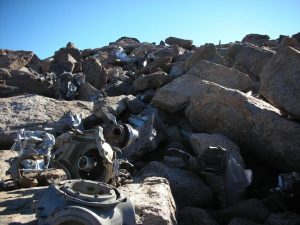 time, and the elements, went on, the paint wore off, and the shining aluminum allowed the plane to be located. The mountain was named “Bomber Mountain” in their memory. I can’t imagine the pain of loss the families of the crew must have felt knowing that their loved one had died, but to have no real idea what happened for two long years…must have been very hard to bear. Knowing where it all happened, while not removing the pain, at least brings peace.
time, and the elements, went on, the paint wore off, and the shining aluminum allowed the plane to be located. The mountain was named “Bomber Mountain” in their memory. I can’t imagine the pain of loss the families of the crew must have felt knowing that their loved one had died, but to have no real idea what happened for two long years…must have been very hard to bear. Knowing where it all happened, while not removing the pain, at least brings peace.

 My grand nephew, Topher Spicer just finished his first year of high school…strange as it might have been. Never before has there been such an unusual ending to a school year, and all because of the Covid-19 virus. We experienced the never-ending spring break, home schooling in families that didn’t intend to home school, and online classes for all grades. Some kids did well, while others struggled with this new reality education. Topher did well. He likes school and learning, and finished his first year of high school with all A’s and B’s. It was something to be proud of.
My grand nephew, Topher Spicer just finished his first year of high school…strange as it might have been. Never before has there been such an unusual ending to a school year, and all because of the Covid-19 virus. We experienced the never-ending spring break, home schooling in families that didn’t intend to home school, and online classes for all grades. Some kids did well, while others struggled with this new reality education. Topher did well. He likes school and learning, and finished his first year of high school with all A’s and B’s. It was something to be proud of.
Topher also had an interesting year, in that he got a job…his first job. Most kids tend to go into retail or fast food for their first job, but Topher managed to land a really interesting job. It has me very impressed. He is  working as a tour guide for The Wyoming Frontier Prison. The prison opened in 1901 and could accommodate 104 prisoners. At that time there was no running water, electricity, and very inadequate heating. The 104 cells were in what is now Cell Block A. An addition completed in 1904 added 32 cells. A second addition, adding Cell Block B in 1950, helped alleviate overcrowding. Cell Block C was added in 1966, with 30 cells for the most serious cases. The prison closed in 1987 and became a historic site in 1988…setting the stage for Topher’s first job. Topher, being the innovative guy he is, loves his job, and enjoys making people laugh at the witty things he has come up with for some of the historical information. Many people find history boring, but Topher helps them understand how things were in a very different era, and makes it interesting while he’s at it…now that’s something to be proud of.
working as a tour guide for The Wyoming Frontier Prison. The prison opened in 1901 and could accommodate 104 prisoners. At that time there was no running water, electricity, and very inadequate heating. The 104 cells were in what is now Cell Block A. An addition completed in 1904 added 32 cells. A second addition, adding Cell Block B in 1950, helped alleviate overcrowding. Cell Block C was added in 1966, with 30 cells for the most serious cases. The prison closed in 1987 and became a historic site in 1988…setting the stage for Topher’s first job. Topher, being the innovative guy he is, loves his job, and enjoys making people laugh at the witty things he has come up with for some of the historical information. Many people find history boring, but Topher helps them understand how things were in a very different era, and makes it interesting while he’s at it…now that’s something to be proud of.
Topher is comfortable in his own company. He is an only child, and always finds ways to occupy his mind. 
 He and his mom, my niece, Andrea Spicer, are good friends, and even into his teenage years, they get along very well. Topher is her right-hand man, helping her with things she needs and doing it without complaint…ok, not too much anyway. Topher plans to spend high school building up his art and theatre credits, and then he is considering going to the University of Wyoming, or possibly to South Dakota. I know that whatever Topher decides to do, he will excel at it and continue to make his family proud. Today is Topher’s 15th birthday. Happy birthday Topher!! Have a great day!! We love you!!
He and his mom, my niece, Andrea Spicer, are good friends, and even into his teenage years, they get along very well. Topher is her right-hand man, helping her with things she needs and doing it without complaint…ok, not too much anyway. Topher plans to spend high school building up his art and theatre credits, and then he is considering going to the University of Wyoming, or possibly to South Dakota. I know that whatever Topher decides to do, he will excel at it and continue to make his family proud. Today is Topher’s 15th birthday. Happy birthday Topher!! Have a great day!! We love you!!
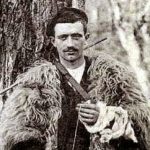 In a time when so much in our world is chaotic and serious, today seems like a good time to explore the lighter side of life. We have all seen the different feats performed for the Guinness Book of World Records. There are many people who attempt and fail to break the world record, and that is sad, because they have worked so hard to set it up, and it would probably take a long time to set it up again. Still, if a world record was easy to obtain, it wouldn’t really be so special.
In a time when so much in our world is chaotic and serious, today seems like a good time to explore the lighter side of life. We have all seen the different feats performed for the Guinness Book of World Records. There are many people who attempt and fail to break the world record, and that is sad, because they have worked so hard to set it up, and it would probably take a long time to set it up again. Still, if a world record was easy to obtain, it wouldn’t really be so special.
In the latter part of the nineteenth century, and long before the August 27, 1955 first publication of the Guinness Book of World Records, a local baker named Sylvain Dornon decided that he was going to make his mark on history. He decided that he was going to a bygone Landaise tradition of walking on stilts. Dornon was a baker in Arcachon, and I’m not sure what made him decide to take on such a feat, when he already had a decent business that needed his attention. Nevertheless, Dornon, who was born in 1858 in Salles, to the east of Arcachon and at the northern tip of the Landes, was fascinated with stilts. Normally, the use of stilts, or “échasses” as they were called, were primarily used by shepherds, because they were an easy way of maneuvering through marshy land and as a means of extending their field of vision when watching over their flock of sheep. Messengers and postmen, keen on time-saving and maintaining a steady step used stilts too, but as the wetlands became drier, the use of stilts began to die out. Dornon hated to see that period end, and decided to do something about it.
In the beginning of his quest, Dornon organized demonstrations and performances. In true street entertainment style, spectators were invited to make generous donations at the end of the show. The concept proved successful, but Dornon felt he and his stilts deserved greater exposure. So, he kicked things into high 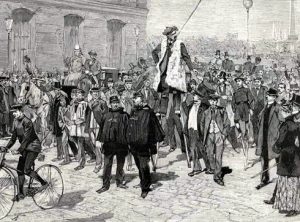 gear, in September of 1889, he travelled to Paris for the Exposition Universelle, and there, he walked up the steps to the second level of the Eiffel Tower. The stunt made Dornon almost a household word, for a while.
gear, in September of 1889, he travelled to Paris for the Exposition Universelle, and there, he walked up the steps to the second level of the Eiffel Tower. The stunt made Dornon almost a household word, for a while.
Dornon was inspired by the publicity he received, and by the tales of eccentric Russians travelling on foot from the western frontier of their country to France. He set himself a goal to stilt-walk all the way from Paris to Moscow, planning his arrival to coincide with a Franco-Russian exhibition being held there in May 1891. The trip would not be a free way to travel, so he set about securing financial backing from the magazine L’Illustration, began making two new pairs of stilts: one set measured 44 inches long and weighed about 7 pounds. The second, longer pair was 70 inches long, and was sent to Moscow, along with trunks of clothes.
Dornon was dressed in full Landais shepherd clothing…including goat-skin coat and beret, carrying a bag containing maps, a few spare clothes and a loaded gun…for safety. He was dressed in the authentic attire for the period he was portraying. Dornon set out from Place de la Concorde in Paris on March 12th 1891, surrounded by a 2,000-strong crowd of enthusiastic supporters! He walked an average of 37 miles a day, which I find amazing, considering that I walk an average of 15 miles a day, and I think that is an accomplishment. Even harsh weather conditions and poor road surfaces, didn’t slow him down. Dornon cruised through Reims, Sedan, Luxembourg, Koblenz, Berlin, Wilna and on to Moscow. He was joined periodically by walkers and cyclists for stretches of the route. Progress was also sometimes hindered by uncooperative policemen or children who would throw stones at him, not to mention downright hostile observers, notably in Germany where the sight of a Frenchman on stilts did not systematically prove popular. There always has to be someone 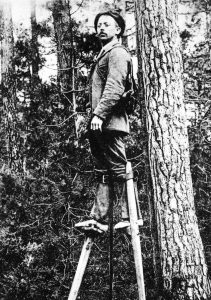 to ruin things. Still, Dornon never failed to find a local who had heard of his venture or a hotel bed to sleep in.
to ruin things. Still, Dornon never failed to find a local who had heard of his venture or a hotel bed to sleep in.
After 58 days and 1786 miles, Dornon arrived in Moscow preceded by a police cortege. He was hailed by a crowd chanting “Vive la France!” and treated to a champagne reception, although the staff at the French exhibition weren’t too impressed. Dornon wasn’t allowed to stilt-walk at the event and wasn’t even given a courtesy ticket…nice, he had to pay to get into his own reception. When the festivities were over, he boarded a train for the much-shorter trip home, where he went back to his job as a baker.
He still liked to take part in races and dance performances throughout the region up until his death in 1900 aged just 42. Dornon did leave a legacy…that of reviving a Landaise tradition which had already died out, and the concept he developed lives on to this day, with many échassier folk dance troupes continuing to entertain the masses.

